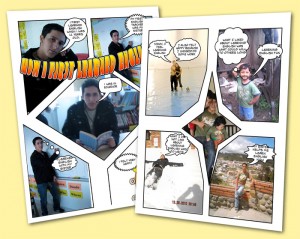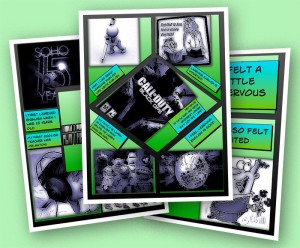Using Comics to Teach English Language Learners
During librarian Dawn K. Wing's time as a high school ESL teacher years ago, she developed curricula that enabled English language learners to practice their English language skills across all modalities by reading and creating visual narratives.

A comic book rendering of Dawn K. Wing, a media and reader services librarian in New York.
Story updated on October 30, 2015 I discovered the power of graphic novels as a language-learning tool while teaching English in Japan in 2006. As a non-Japanese speaker, I was encouraged by my colleagues to learn more vocabulary by reading manga or comics, specifically the classic comic strip Sazae-san (Kodansha International, 1997). Since then, I have become an avid reader and teacher of graphic novels. In Japan, manga is everywhere. It was not unusual to see students reading it in the classroom, between classes, or in the cafeteria. If you’re a high school teacher in the United States today, the sight of graphic novels in the hands of a teen reader is not uncommon. From 2008–2011, I taught English as a Second Language (ESL) at Pan American International High School in Elmhurt, NY. I was excited to share the love and passion I’d acquired for graphic novels with my students. Fortunately, I had colleagues and literacy coaches who were already experienced in creating curricula around teaching graphic novels like Marjane Satrapi’s Persepolis (Pantheon, 2004) and Gene Luen Yang’s American Born Chinese (First Second, 2006) that supported English language learners’ (ELL) development in multiple literacies. Studies have also shown increased engagement and vocabulary development in ELLs when reading graphic novels and producing visual narratives. During my tenure as a high school ESL teacher, I developed curricula that enabled students to practice their English language skills across all modalities by reading and creating visual narratives. Teaching graphic novels with ELLs requires specific planning and scaffolding of activities. Here are some of my best practices for using graphic novels in the ESL classroom.Teaching Art Spiegelman’s Maus

Wing had her students tell their immigrant stories using comic book software.
When planning to teach reading comprehension and literary analysis to ELLs using graphic novels, it is best to assess students’ prior experiences with visual narratives and subject interests. From survey results gathered at the beginning of the fall 2009 semester, I realized most of my 11th grade intermediate and advanced ESL students wanted to learn more about world history. From my research, using online educator resources such as the International Literacy Association’s Read Write Think website, I decided to teach Art Spiegelman’s Maus (Pantheon, 1991), the Pulitzer prize−winning graphic novel about the journey of his father, who survived the Holocaust. Although a number of students were familiar with reading manga, others needed to learn the basic visual grammar of graphic novels. This meant providing explicit instruction of graphic novel terminology such as panels, dialogue, captions, and speech bubbles. Because I had a mixed-level class, I chose excerpts from Maus for students to read aloud during class, combining excerpts that focused primarily on the main character’s experience living in concentration camps. To help students understand the historical context of the story, I did in-class activities about Polish ghetto life. Students matched captions I’d written to select photographs of Mendel Grossman, whose work was published in the book My Secret Camera (HMH books, 2000). I also facilitated activities using PowerPoint presentations, explaining the causes and outcomes of World War II, and focusing on the rise and fall of Nazi powers in Europe. During class, students enjoyed reading aloud select pages from Maus while writing their thoughts and responses to questions in reading guides that I’d created. They were prompted to review what happened in a scene, foreshadow what might happen later, and analyze the symbolism Spiegelman uses in the story. Students were asked why they thought the author chose to represent Jews as mice and Germans as cats, and how this device was effective to convey key concepts of the story. After collectively analyzing Maus, students were asked to write a comparative literary essay using this story and another work of literature. I created a packet that scaffolded the essay writing process that would help prepare students for the required New York State English Language Arts Regents exam. Overall, the students were engaged throughout our selected chapter readings and discussions of Maus. A few extended their interest in learning about the Holocaust by opting to go on a field trip to the Brooklyn Academy of Music to watch a puppetry production about Auschwitz later that semester.Creating educational comics
If you’re having difficulty finding educational comics or visual narratives on a specific topic, you can make your own. Finding visual books that target the interests of high school ELLs, especially Students with Interrupted Formal Education (SIFE) or beginner ELLs, can be challenging. However, teachers can produce their own educational comics that cater to their students’ reading abilities. Using Microsoft Word, Comic Life, and Internet images, I have created custom visual reading materials about the immigration experience through Ellis Island and have adapted folklore into comic form. Another benefit of creating one’s own educational comic is the ability to customize text for students of varying English proficiencies in the same classroom. It is a great way to differentiate learning materials.Students making comics

Wing's students used software, including Microsoft Word and Comic Life, to create their own comic books.
Students enjoyed producing personal narrative comics about their experiences immigrating to the United States and learning English. The opportunity to combine text with pictures enabled them to communicate the complexities of their stories while integrating new vocabulary into their writing. They also learned to use pronouns and verb tenses appropriately when writing dialogue and internal thoughts using word bubbles. The comic strip format also lends itself naturally as a visual scaffold for students to write information in a sequential order. To guide students in creating coherent narratives, I provided templates with panels and word prompts containing transition words and phrases. We also went over key vocabulary words relating to places, travel, and immigration. I created handouts with sentence prompts that served as drafts for students to practice their writing, as well as drawings that they were able to use as practice templates to read, review, and self-correct with my guidance. I offered students the option of using Comic Life or drawing their comics by hand. Many selected Comic Life, as it allowed them the opportunity to practice online image searching and advance their literacy with technology. My students were genuinely excited about this project, because it was a way for them to be heard and to share with others how they were dealing with their current circumstances. When they saw their comics project published and complete, I was touched when students asked for extra copies. Many wanted to send them to parents still living in their home countries to let them know how they were doing in the United States. Additional Resources To find teaching materials for lesson activities and student guides mentioned in this article, visit Comicsforells.weebly.com. Besides Maus, another graphic novel series discussing WWII atrocities is Keiji Nakazawa’s Barefoot Gen (New Society, 1994), which examines the impact of the atomic bombing of Hiroshima and its aftermath through the lens of a young survivor. For intermediate to advanced ELLs, colleagues of mine have used books such as Persepolis by Marjane Satrapi (Pantheon, 2003) and American Born Chinese by Gene Luen Yang (First Second, 2006), where students explored cultural, political and personal identity issues while developing skills in literary analysis. Great for ELLs of all levels but especially for SIFE and beginners with limited English abilities, Shaun Tan’s wordless book The Arrival (Arthur A. Levine, 2007) is an immigration story told through beautiful illustrations. With this book, students have the opportunity to produce language by writing captions and dialogue to narrate what characters are doing and feeling. The various visual travelogues created by Guy Delisle (The Burma Chronicles, Jerusalem, Shenzhen, and Pyongyang) can be used to inspire students to reflect, write and illustrate their own day-to-day observations about living in a new country. Lastly, Getgraphic.org is a website where you can find more information about different types of graphic novels, a listing of titles which includes grade levels and abstracts and instructional materials. It also provides links to other graphic novels-related websites. Need funding for a classroom set of graphic novels? Or interested in starting a graphic novels collection at your library? Consider applying for the following:- Funding for Books - DonorsChoose.org
- Will Eisner Graphic Novels Grants for Libraries - American Library Association
Dawn K. Wing is the Media and Reader Services Librarian at Suffolk County Community College in Selden, NY. She currently oversees the library’s growing graphic novels collection and enjoys integrating media into information literacy instruction. She taught English as a Second Language at Pan American International High School in Elmhurst, NY from 2008–2011.
RELATED
RECOMMENDED
CAREERS
The job outlook in 2030: Librarians will be in demand
CAREERS
The job outlook in 2030: Librarians will be in demand
ALREADY A SUBSCRIBER? LOG IN
We are currently offering this content for free. Sign up now to activate your personal profile, where you can save articles for future viewing





Add Comment :-
Comment Policy:
Comment should not be empty !!!
Jane
I use this service: http://wuppsy.com/flash-memory-cards-printable-generator/ It helps to learn foreign words very wellPosted : Aug 14, 2015 09:07
Hiroko Miyashita
Hi. I'm a Japanese language teacher in NYC and using Japanese anime and manga to teach Japanese. I've never tried to let my students to create their own manga in Japanese yet, but it should be a great idea to try out! Thank you for sharing your ideas and experiences!Posted : Aug 10, 2015 11:16
Jane Fox
This is an intriguing idea. I have to admit, when I think learning English, I don't immediately think Maus. It sounds like an effective way to engage students. I was certainly riveted when I read it, so I can imagine that anyone learning English at a school would be likewise enthralled, which can only help their learning. Do you think Maus might be a little dark for some people? Are there other alternatives you think might be as helpful?Posted : Jun 01, 2015 06:44